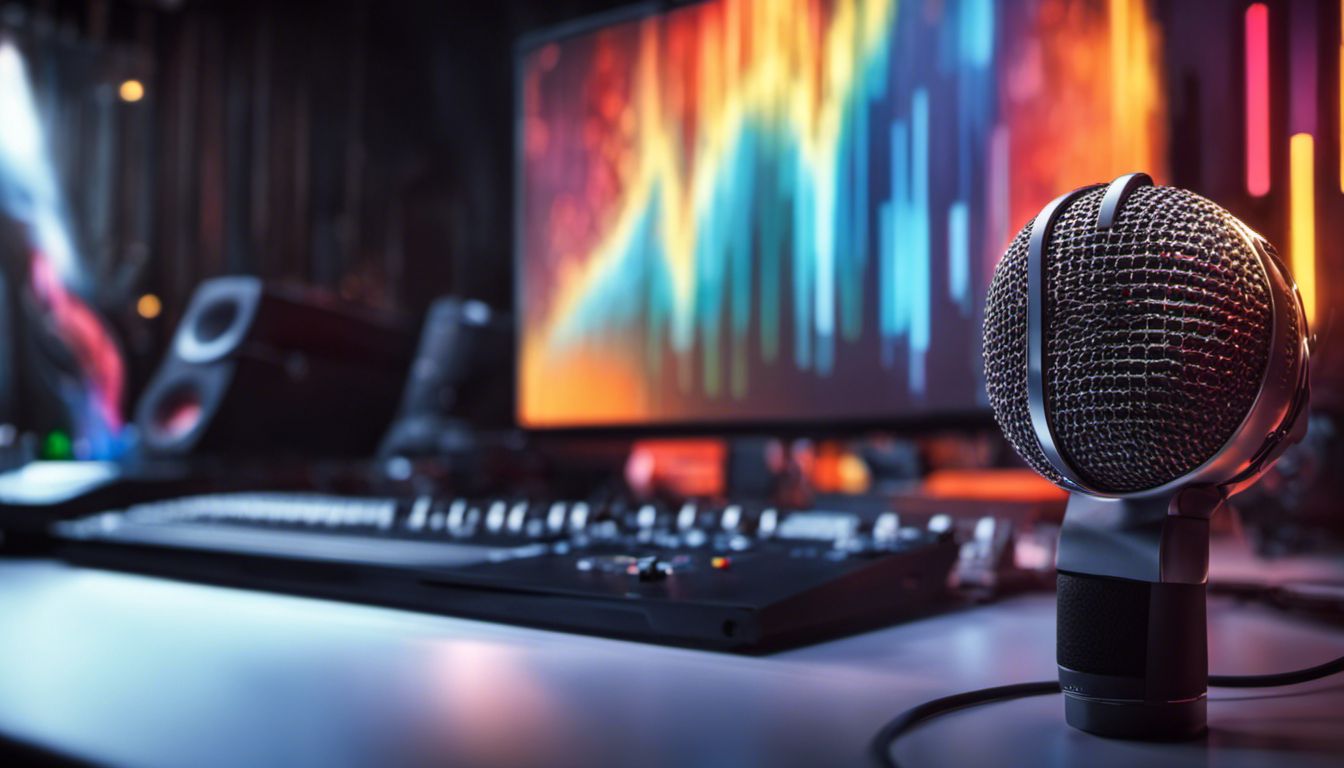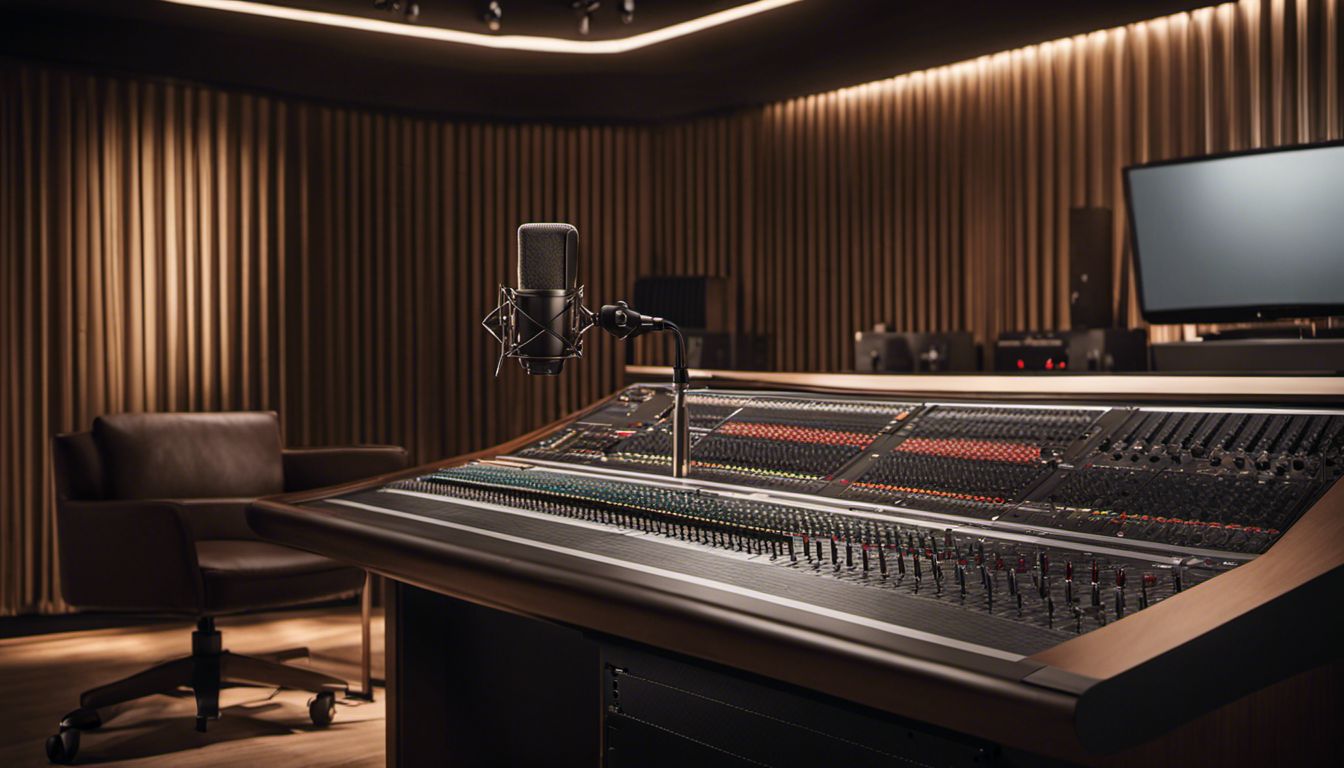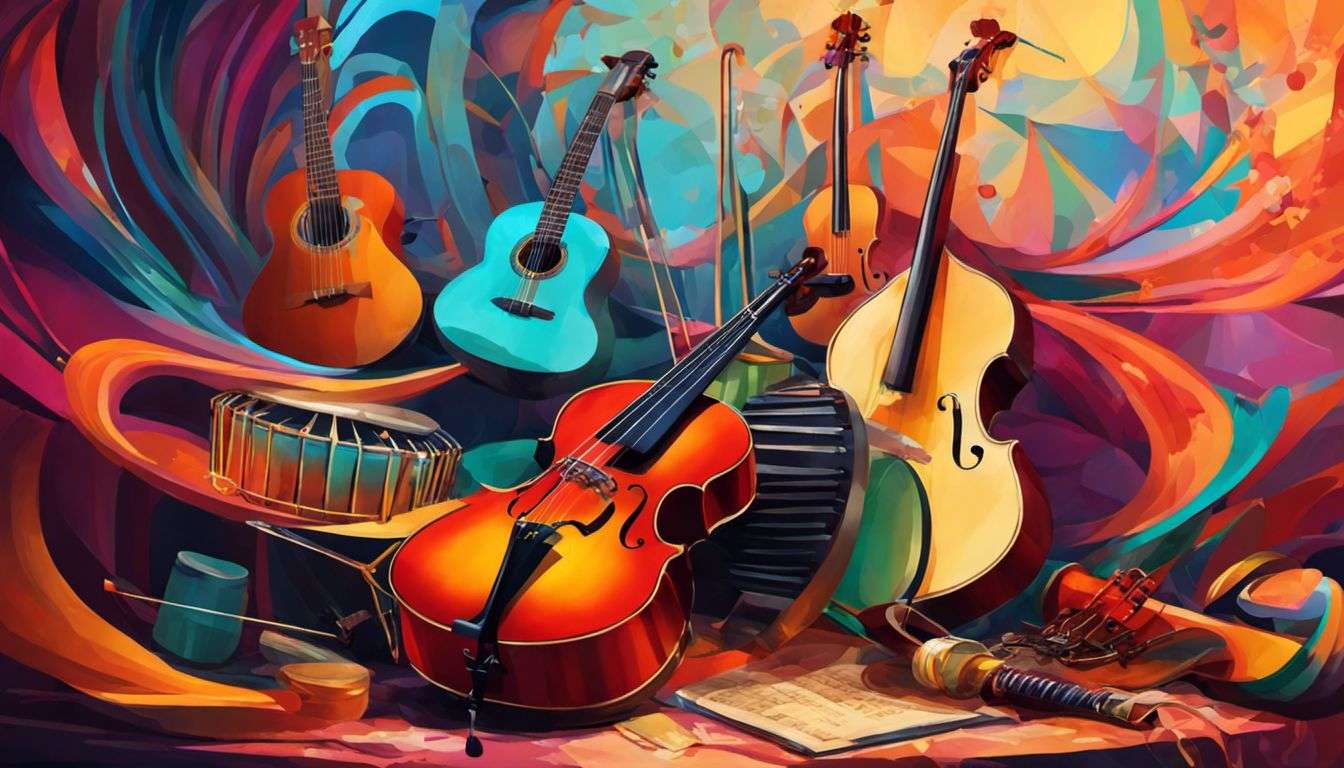Struggling to make your video content more engaging? A well-designed sound can make all the difference. In this comprehensive guide, we demystify the complex world of sound design for videos, providing you with practical tips and techniques to enhance your work.
So get ready – it’s time to amplify your storytelling abilities!
Key Takeaways
- Sound design for videos involves creating and manipulating audio elements to enhance the overall visual experience.
- Elements of sound design include selecting sound effects, timing music, layering ambiance, synchronizing sound with video action, incorporating Foley artistry, designing dialogue tracks, utilizing pre-recorded songs, creating original music composition, constructing cinematic sound, and making post-production edits.
- Sound design plays a crucial role in capturing audience attention and immersing them into the visuals on screen.
- Tools and resources for sound design include digital audio workstations (DAWs), plugins, sample libraries, field recording equipment, sound libraries, sound effects generators.
- Sound design enhances the visual experience in videos by manipulating audio elements like sound effects and music.
- It plays a crucial role in capturing audience attention and immersing them into the visuals on screen.
- Tools like DAWs and plugins are used to record and edit audio tracks while sample libraries provide pre-recorded sounds for use in sound design.
- Foley artists recreate realistic movements and sounds using physical objects during post-production.
Understanding Sound Design for Videos
 Sound design for videos involves the creation and manipulation of audio elements to enhance the overall visual experience.
Sound design for videos involves the creation and manipulation of audio elements to enhance the overall visual experience.
What is sound design?
Sound design shapes the audio experience of a production, be it video games, films or live performances. It brings together different elements like ambiance sounds, sound effects and music to create an immersive sensory landscape for viewers.
With the aid of modern technology, sound designers can mimic real-life noises or even generate unique auditory experiences that push beyond reality’s boundaries. Whether used subtly or forcefully, effective sound design adds depth and dimension to visual content enhancing narratives by punctuating moments with dramatic impact or providing subtle emotional cues.
Sound design techniques also help control and manipulate viewer’s emotions – an important tool in storytelling!
Elements and practices of sound design
Sound design for videos involves a variety of elements and practices. These range from the careful selection of sound effects to the rhythmic timing of music and dialogue.
- Selecting Sound Effects: Designers choose sounds that enhance the video’s visual content. This includes both naturalistic sounds, such as bird songs or traffic noise, and abstract noises that contribute to mood manipulation.
- Timing Music: Precise timing is integral to effective sound design. Music tracks must be synchronized with video sequences to generate emotional responses or underscore dramatic moments.
- Layering Ambiance: Designers layer various ambient elements for a richer audio experience. This could include background noise, echoes, or reverberation.
- Synchronization: The synchronization of sound with video action is crucial for realism. This could involve matching footsteps with characters’ movements or aligning dialogue with lip movements.
- Incorporating Foley Artistry: Foley artists replicate real world sounds in studios for greater authenticity in sound design.
- Designing Dialogue Tracks: Clear and impactful dialogue demands meticulous work on volume levels, clarity enhancement, background noise removal and tonal balance adjustment.
- Utilizing Pre-recorded Songs: Depending on project needs, designers may incorporate pre-recorded songs which fit the video’s theme and mood.
- Creating Original Music Composition: For unique projects, designers might need to create original music matching the specific emotional context of scenes.
- Cinematic Sound Construction: Sound designers often use layered effects to achieve cinematic sound – boosting drama or suspense in films.
- PostProduction Edits: Final alterations are made during audio post-production including focus shifts between different layers of ambiance based on scene requirements.
The Role of Sound Design in Videos

Sound design plays a crucial part in capturing the audience’s attention and deeply immersing them into the visuals on screen. It is no longer merely an addition or enhancement; it has become an essential component of storytelling.
A well-crafted sound augments a video’s visual elements, reinforcing scenes’ mood, creating tension, or triggering emotional responses for viewers.
The synchronization of sounds with videos adds authenticity to each shot. It can replicate real-world noises that may be impossible to capture while filming or create nonexistent audio that enhances a scene’s impact – from thunderous explosions to subtle footsteps echoing in suspenseful silence.
Original music creation further conveys themes and emotions, strengthening the overall narrative’s coherence and depth. Whether using pre-recorded songs or layers of ambiance crafted by Foley artists, skillful sound design transforms ordinary footage into compelling viewing experiences.
Tools and Techniques for Sound Design
Learn sound design techniques through online tutorials and find inspiration from other filmmakers who have mastered the art. Access a wide range of sound design tools and resources to enhance your videos with professional-level audio effects.
Sound design tutorials
Learn how to master sound design for your videos with these helpful tutorials:
- Explore the fundamentals of sound design and how it enhances the overall video experience.
- Discover different techniques for designing sound effects that add depth and realism to your videos.
- Learn how to create ambiance and foley sounds to bring your scenes to life.
- Understand the importance of synchronization between sound and video for a seamless viewing experience.
- Dive into the world of music composition and learn how to create original music for your sound design.
- Get insights on layering sound effects to create a more immersive audio environment.
- Uncover tips for creating realistic sound design for movies, using techniques employed by professional filmmakers.
- Gain a deeper understanding of the role of sound mixing in post – production and its impact on the final product.
Inspiration from other filmmakers
Filmmaking is an art form that thrives on inspiration, and sound design is no exception. Many filmmakers have pushed the boundaries of sound design, creating innovative techniques and approaches that can inspire and inform your own work.
By studying the works of renowned filmmakers, you can gain valuable insights into their methods and use them as a springboard for your own creativity. Whether it’s exploring the intricate soundscapes of David Lynch or the rhythmic editing style of Edgar Wright, taking in the work of other filmmakers can spark new ideas and help elevate your sound design to new heights.
In addition to studying their films, you can also delve into interviews, documentaries, or behind-the-scenes footage where these filmmakers discuss their approach to sound design. This behind-the-scenes look allows you to understand their thought process and gain deeper insights into how they use sound to enhance storytelling.
Sound design tools and resources
Sound design for videos requires the use of various tools and resources to enhance the audio experience. Here are some essential tools and resources that can help filmmakers achieve professional sound design:
- Digital Audio Workstations (DAWs): Software programs like Pro Tools, Logic Pro, and Ableton Live allow sound designers to record, edit, and mix audio tracks.
- Plugins: These software add-ons provide additional features and effects to DAWs, such as EQ, compression, reverb, and delay.
- Sample Libraries: Pre-recorded sounds, including Foley effects, ambient noises, and musical instruments, are available in sample libraries. They can be easily imported into a project for use in sound design.
- Field Recording Equipment: Sound designers often capture their own original sounds using equipment like portable recorders and microphones. This allows for more unique and customized audio elements.
- Sound Libraries: Stock sound libraries offer a vast collection of professionally recorded audio clips that can be used for various purposes in sound design.
- Sound Effects Generators: Programs like Native Instruments’ Kontakt or Spectrasonics’ Omnisphere provide a wide range of synthesized sounds that can be manipulated to create unique effects.
- Foley Props: Physical objects such as shoes, doors, and utensils are used by Foley artists to recreate realistic movements and sounds during post-production.
- Collaboration Platforms: Online platforms like Dropbox or Google Drive enable sound designers to share files with clients or team members easily.
- Tutorials and Online Learning Resources: Websites, YouTube channels, and online courses provide valuable tutorials on sound design techniques and best practices.
- Community Forums: Engaging with fellow sound designers through forums offers opportunities to learn from others’ experiences and exchange ideas.
- Professional Sound Design Services: For those who prefer outsourcing their sound design needs or require specialized expertise, hiring professional sound design services is an option worth considering.
Different Types of Sound Design
Explore the world of sound design with hits, drones, whooshes, and more to create dynamic and immersive videos. Discover the secrets to achieving a captivating sound in your projects.
Keep reading for expert tips and techniques!
Hits, drones, whooshes, swells, rises, and suckbacks
Sound design for videos involves incorporating various elements to enhance the auditory experience. This includes utilizing hits, drones, whooshes, swells, rises, and suckbacks.
Utilizing various elements for a more dynamic sound
Creating a dynamic sound design for videos involves utilizing various elements to enhance the overall experience. By incorporating different techniques, such as layering sound effects and adding ambient sounds, you can bring depth and richness to your audio.
For example, using hits, whooshes, rises, and other elements strategically can add excitement and impact to key moments in your video. Additionally, experimenting with different combinations of sounds can help create unique textures and moods that complement the visuals.
By exploring these various elements of sound design, you can take your videos to the next level and captivate your audience’s attention.
The Process of Sound Design
Sound design is an iterative process, combining various elements to create a cohesive and dynamic sound. From designing sound effects to creating original music, this section explores the step-by-step tutorial on how to achieve realistic sound design for videos.
Read more to discover the secrets behind creating captivating audio that enhances storytelling in your videos.
An iterative process
In the process of sound design for videos, it is important to remember that it is an iterative process. This means that it involves constantly revising and refining the sound elements to achieve the desired result.
It starts with brainstorming ideas and experimenting with different sounds and techniques. Then, these ideas are implemented, and the sound design is tested alongside the video footage to see how well they synchronize.
Feedback is gathered from viewers or clients, leading to further adjustments and improvements in subsequent iterations. This iterative approach ensures that the final sound design effectively enhances the overall viewing experience without compromising on clarity or quality.
Combining design elements for a cohesive sound
To create a cohesive sound design, it is important to combine various design elements. This involves:
- Layering different sound effects and music compositions
- Syncing the sound design with the visuals in the video
- Replicating realistic sounds through foley artistry
- Creating original music for unique sound design
- Adding layers of ambiance to enhance the overall audio experience
Design overload and creating a climax
To avoid design overload and create a powerful climax in your sound design, it is important to strike the right balance between complexity and simplicity. While adding layers of audio elements can enhance the depth and richness of your sound, too much complexity can overwhelm the viewer and detract from the overall experience.
Instead, focus on strategically placing key sound effects and music cues at critical moments to build tension and anticipation. By carefully crafting the timing, intensity, and progression of your audio elements, you can create a climactic moment that leaves a lasting impact on your audience.
Professional Sound Design Services
Sound designers play a crucial role in enhancing the overall audio experience of videos and films, bringing them to life through their expertise in manipulating sound elements.
What does a sound designer do?
A sound designer is responsible for creating and manipulating audio elements to enhance the overall experience of a video or film. They work closely with filmmakers to understand their vision and bring it to life through the use of sound effects, music, and ambiance.
A sound designer may create original music compositions, design realistic sound effects, synchronize audio with video footage, and layer different elements to create depth and immersion.
Their goal is to enhance storytelling by evoking emotions, setting the mood, and providing a seamless auditory experience for the audience.
The difference between sound design and mixing
Sound design and mixing are two distinct but equally important processes in the world of audio production. While both involve manipulating and enhancing sound, they serve different purposes.
Sound design focuses on creating and designing original sounds that enhance the overall mood, atmosphere, and storytelling of a video or film. It involves incorporating elements such as sound effects, ambiance, foley artistry, and even composing original music specifically tailored to match the visuals on screen.
On the other hand, mixing is about balancing and fine-tuning all the audio elements in a project to ensure clarity, coherence, and optimal sound quality. This includes adjusting volumes levels, panning sounds across speakers for a more immersive experience, EQing frequencies to achieve tonal balance, adding reverbs or other effects for spatial enhancement if necessary.
Examples of sound design services for videos and films
- Sound effects creation and implementation
- Foley sound design for realistic audio
- Ambience and atmospheric sound design
- Music composition and scoring
- Dialogue editing and cleaning
- Synchronization of sound with video footage
- Mixing and balancing of audio elements
- Creating soundscapes for immersive experiences
- Audio post – production for films and videos
Conclusion
Mastering sound design for videos requires a deep understanding of its elements and techniques. By utilizing the right tools, learning from experts, and exploring different types of sound design, you can create a more immersive experience for your audience.
Whether it’s syncing sound with video or creating original music, this ultimate guide has equipped you with the knowledge to take your videos to the next level. So go ahead and start experimenting with sound design to enhance storytelling in your films!
Is Color Grading an Important Aspect of Video Sound Design?
When it comes to video sound design, color grading fundamentals unlocked play a crucial role. While sound design aims to enhance the auditory experience, color grading enhances the visual aspect of a video. By adjusting colors, tones, and contrast, color grading ensures consistency and enhances the overall mood and atmosphere, leading to a more immersive viewing experience. It complements sound design by adding depth and coherence to the visual narrative.
How Can I Apply Innovative Sound Design Ideas in Videos?
The world of video production offers endless possibilities for incorporating innovative sound design techniques for creativity. By experimenting with unconventional sounds, layering different audio elements, and utilizing cutting-edge technology, filmmakers can enrich the viewer’s experience. From creating unique soundscapes to amplifying emotions, innovative sound design can elevate videos to new heights, captivating audiences and leaving a lasting impact.
FAQs
1. What is sound design for videos?
Sound design for videos refers to the process of creating and manipulating audio elements to enhance the overall auditory experience in a video, including background music, sound effects, and dialogue.
2. How can I improve the sound quality in my videos?
To improve sound quality in your videos, you can use a high-quality microphone, record in a quiet environment, adjust audio levels properly during editing, and add post-production effects like equalization and noise reduction.
3. What are some techniques for effective sound design?
Some techniques for effective sound design include using appropriate ambient sounds to create atmosphere, syncing audio with visual cues, layering different sounds to add depth and dimension, and utilizing panning or stereo imaging effects.
4. Where can I find royalty-free music or sound effects for my videos?
There are various websites that offer royalty-free music and sound effects libraries such as YouTube Audio Library, SoundCloud’s Creative Commons section, or paid platforms like Epidemic Sound or Artlist.
5. Are there any best practices I should follow when it comes to sound design for videos?
Yes! Some best practices include maintaining consistent audio levels throughout the video, ensuring clear dialogue by minimizing background noise or using subtitles when necessary. Additionally experimenting with different combinations of music and sounds to evoke emotions relevant to your content is also advised.






